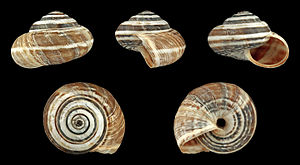Cernuella
| Cernuella | ||||||||||||
|---|---|---|---|---|---|---|---|---|---|---|---|---|

Mediterranean heather snail ( Cernuella virgata ) |
||||||||||||
| Systematics | ||||||||||||
|
||||||||||||
| Scientific name | ||||||||||||
| Cernuella | ||||||||||||
| Schlueter , 1838 |
Cernuella is a genus of snails from the family of Geomitridae in the order of land snails (Stylommatophora).
features
The housings are spherical to almost flat. They measure 6.5 to 10.5 mm in height and 12 to 18 mm in width. They have five to six and a half, more or less strongly arched turns, which increase regularly. The last turn does not or only slightly descends towards the mouth. The mouth is rounded and is slightly to moderately slanted to the axis of the coil. Typically the inside of the mouth is reddish to brownish in color. The mouth edges are sharp with an inner lip at the bottom; it can also be absent. The umbilicus is open and narrow to cylindrical or cup-shaped.
The skin is whitish, yellowish to brownish; the drawing consists of dark bands. The embryonic convolutions are smooth. The surface shows weak to coarser growth strips.
In the hermaphroditic genital apparatus, the flagellum in the male tract is short to medium-long at the point where the vas deferens enter the epiphallus. The epiphallus is usually very long. The penile retractor muscle attaches to the distal part of the epiphallus near the junction with the penis. The penis is cylindrical to spindle-shaped. It is innervated by the right foot ganglion. There are two arrow sacks, an inner arrow sack and an outer arrow sack, in which the only love arrow is located. Seen from the outside, both arrow sacks have grown together to form a two-humped arrow apparatus. Inside, the arrow apparatus forms a conical structure that protrudes into the vagina and genital atrium. The arrow apparatus sits at the distal end of the genital atrium, after the penis joins the genital atrium (ie distal, closer to the genital opening). The atrium is usually very short, always wider than it is long.
Geographical distribution and habitat
The distribution area of the genus is southern Europe, western Europe, central Europe, the Balkans to Greece and North Africa. An individual record also comes from southern Scandinavia. The species of the genus prefer warm, sunny, dry and open locations, preferably on calcareous subsoil. In the case of prolonged drought, they hide under stones or keep a drought and seal their housings with a diaphragm.
Taxonomy
The taxon was drawn up in 1838 by Friedrich Schlueter . Cernuella is the type genus of the tribe Cernuellini Schileyko, 1991. The genus is divided by some authors into two or three subgenus Cernuella (Cernuella) , Cernuella (Xerocincta) and Cernuella (Alteniella) Clerx & Gittenberger, 1977. Alteniella is also understood as an independent genus. The following species are currently included in the genus Cernuella :
- Cernuella aginnica (Locard, 1882)
- Cernuella amanda (Rossmässler, 1838)
- Cernuella aradasii (Pirajno, 1842)
- Cernuella caruanae (Kobelt, 1888)
- Wasteland heather snail ( Cernuella cisalpina (Rossmässler, 1837))
- Cernuella hydruntina (Kobelt, 1883)
- Cernuella jonica (Mousson, 1854)
- Cernuella lampedusae (Kobelt, 1890)
- Red-mouthed heather snail ( Cernuella neglecta (Draparnaud, 1805))
- Cernuella rugosa (Lamarck, 1822)
- Cernuella selmaniana Brandt, 1959, Libya
- Cernuella tineana (Benoit, 1862)
- Mediterranean heather snail ( Cernuella virgata (Da Costa, 1778))
- Cernuella zilchi Brandt, 1959
supporting documents
literature
- John PM Clerx, Edmund Gittenberger: A few things about Cernuella. Zoological Mededelingen Leiden, 52 (4): 27-56, 1977 PDF
- Bernhard Hausdorf, Jan Sauer: Revision of the Helicellinae of Crete (Gastropoda: Hygromiidae). Zoological Journal of the Linnean Society, 157: 373-419, 2009 doi : 10.1111 / j.1096-3642.2008.00504.x
- Anatolij A. Schileyko: Treatise on Recent terrestrial pulmonate molluscs, Part 14 Helicodontidae, Ciliellidae, Hygromiidae. Ruthenica, Supplement 2 (14): 1907-2047, Moscow 2006 ISSN 0136-0027 (publication date corrected in vol. 15, p. 2115) (p. 1986)
Individual evidence
- ↑ Friedrich Schlueter: Brief systematic index of my conchylia collection with an indication of all land and river conchylia that I have found near Halle up to now. Compiled to facilitate the exchange for friends of conchyliology. P. I-VII, 1-40, Halle, Gebauer, 1838 Online at www.biodiversitylibrary.org (P. 6).
- ↑ MolluscaBase: Cernuella Schlüter, 1838